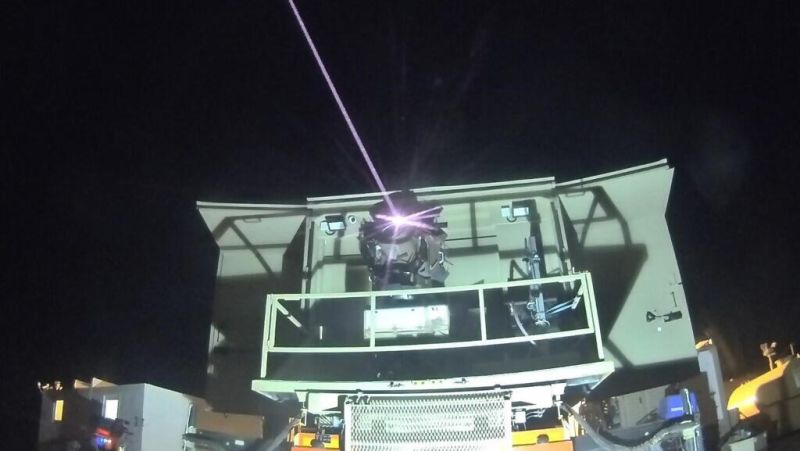Israel expects its “Iron Beam” laser defense system to be operational within one year, saying it will bring “a new era of warfare” as it engages in a war of drones and missiles with Iran and its regional partners.
The Jewish state spent more than $500 million on deals this week with Israeli developers Rafael Advanced Defense Systems, architect of Israel’s Iron Dome, and Elbit Systems to expand production of the shield. Dubbed the Iron Beam, the shield aims to use high-power lasers to counter an array of projectiles, including missiles, drones, rockets and mortars, Israel’s defense ministry said this week.
“It heralds the beginning of a new era in warfare,” Eyal Zamir, director general of the defense ministry, said in a statement this week. “The initial capability of the ground-based laser system… is expected to enter operational service within one year,” he said.
Israel first unveiled a prototype of the Iron Beam in 2021 and has since been working to get it up and running.
The defense ministry’s comments come as Israel presses on with wars in Gaza and Lebanon, and after its military engaged twice in direct missile attacks with Iran.
Since Israel began its war on Hamas in Gaza last year, following the October 7 attack, it has also been fighting a war with the Iran-backed “Axis of Resistance” across Lebanon, Yemen, Syria and Iraq. Iran and its partners have been seeking to overwhelm Israel’s Iron Dome by pelting it with various projectiles, from rockets and drones to mortars and ballistic missiles, experts previously said.
From southern Lebanon, where Israel is now waging a ground war, Hezbollah’s rockets have reached deep inside Israel. Earlier this month, Israeli Prime Minister Benjamin Netanyahu’s beachside home in the coastal city of Caesarea was damaged in a drone strike claimed by the Shiite Lebanese group. One of the three drones that were launched evaded Israel’s aerial defense system.
Experts say the Iron Beam could be an added layer of defense for Israel, both in terms of effectiveness and cost.
How does it work?
The system uses a high-power laser that is stationed on the ground. With a range of hundreds of meters to several kilometers, the laser heats up the target’s shell in vulnerable areas, including its engine or warhead, until the projectile collapses.
This is different to Israel’s traditional means of destroying missiles and rockets, where radar is used to identify an incoming threat and then an interceptor missile is fired to destroy the projectile midair.
Compared to the Iron Dome, a laser shield would be cheaper, faster and more effective, experts said.
Israel has been intercepting projectiles almost daily since the war with its northern neighbor began. Just on Tuesday, some 50 projectiles crossed from southern Lebanon into Israeli territory, the Israel Defense Forces (IDF) said, adding that some were intercepted and others weren’t.
Rafael Advanced Defense Systems, which is helping produce the Iron Beam, said that a laser defense system has “almost zero cost per interception.” In 2022, former Prime Minister Naftali Bennett said each laser-based interception was expected to cost just $2.
The laser system would be most effective against drones, experts said, which Israel’s Iron Dome has repeatedly failed to intercept.
While Israel’s Iron Dome does intercept and destroy most projectiles, it is primarily designed to counter rockets and missiles, not drones. Unmanned aerial vehicles (UAVs) are small, light and have a low radar signature, which means Israel’s radar systems will not always detect them the way they detect missiles, which are bigger, experts said. Drones also don’t always have a set destination and may change direction mid-travel.
The laser system will be very effective against drones, Kalisky said. The laser will be able to effectively “heat and destroy” drones and UAVs.
Who else has it?
Other governments have experimented with different types of laser systems. The US Navy has tested high-energy laser weapons that can destroy aircraft mid-flight and the United Kingdom has recently showcased a laser-energy weapon called DragonFire that can be used against aerial threats. The Pentagon has also said that China and Russia are developing lasers that could target satellites.
It is unclear if Iran has developed a laser defense system of its own. In 2022, Iran said it was “capable of manufacturing laser weapons to defend… sensitive regions,” state media said.
Iran is, however, suspected to have the Chinese-made “Silent Hunter” laser weapon, experts said, adding that the laser is not as high-powered as the ones designed for the Iron Beam.
Will it really be a gamechanger?
An Israeli Iron Beam would still have its drawbacks.
The laser system would not operate well in cloudy, rainy or hazy weather, experts said, adding that this decreases the laser’s ability to pass through the atmosphere and reach its target. The system would also require great amounts of power to keep it running.
The project’s aspirations and expected timeframe also remain unclear.
One of the main problems was that to meet their aspirations with this laser technology, governments always needed billions of dollars and decades of research, Bruchmann said. The world is yet to see if Israel “actually cracked the code this time,” and can operate it by next year, he said.
Kalisky of the INSS said that, while it is unclear if the Iron Beam will indeed be a “gamechanger” for Israel, it will still be “another layer of defense,” adding that it will likely be most effective against drones and short-range rockets and missiles. It may not be as effective against ballistic missiles, he said, which Israel’s Arrow 2 and Arrow 3 interceptors have traditionally thwarted.
Experts say the Iron Beam could also act as a deterrent to further attacks by Iran or its proxies. Last month, The New York Times reported that Hamas was keen to carry out its October 7 attack by the end of 2023, fearing Israel would start deploying its laser system, which would have been more effective against Hamas rockets. The newspaper was citing documents seized by the Israeli military and obtained by the Times.
“Iran and its proxies (may) calculate that this would be, from their point of view, a gamechanger,” Bruchmann said, “that it would seriously devalue the tens or hundreds of thousands of missiles they are building up as a strategic arsenal to deter Israel.”





